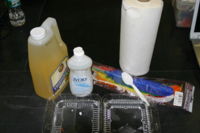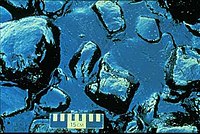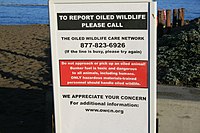This Oil Makes a Royal Mess
| Instant wiki maker | Making handouts | Editing tips |
Contents
Biology In Elementary Schools is a Saint Michael's College student project from a course that ran between 2007 and 2010 and fully described in this book chapter. The student-created resources have been preserved here for posterity. Link under 'toolbox' for printer-friendly versions of the exercises. Click on handouts to print full resolution versions. Please see Wikieducator's disclaimer, our safety statement, and the Creative Commons licensing in English and in legalese.
Student worthiness
This project has been tested and worked well! It was created for students in the third grade.
Primary biological content area covered
This experiment will:
- explore the effects of oil spills on the environment
- explore the effects on animals (specifically birds)
- explore the effects on health of animals that come in contact with oil
Materials
You Need:
- - two bowls for each group of students (usually in pairs)
- - one towel per group (or a roll of paper towels)
- - enough tap water to put in all the bowls
- - 2 bags of feathers for the class
- - two tablespoons of vegetable oil per group
- - two tablespoons of dish washing liquid per group
- - one spoon per group
Handouts
Description of activity
Students will observe the effects of an oil spill in a body of water. They will use feathers to represent a bird and examine the effects of oil on the feather.
Lesson plan
- Fill one bowl with cool tap water.
- Dip a feather into the water. Shake when removed. (See Figure 3)
- Ask the students to observe what happens to the feather when it is wet. Does the water stick to the feather?
- Pat the feather dry with a towel.
- Next, add a tablespoon of oil to the water. (See Figure 4)
- Dip the feather into the oily water. Pat the feather dry with a towel.
- Ask the students to observe what has happened to the feather now that it is covered in oil. Does it look the same as the feather in step three? (See Figure 5)
- Fill the second bowl with tap water. Submerge the oily feather into the bowl. Ask the students if the water cleans the feather. How does the feather look now? (See Figure 6)
- Add dish soap to the water and gently rub the oily feather in the soapy water. (See Figure 7)
- Ask the students to observe what has happened to the feather now that it has been washed. Does the oil come off?
- Use a spoon to mix the water and oil together. Ask students to think of a way to clean the oil out of the bowl. (See Figure 8)
- Photographs of the experiment in progress
Potential pitfalls
- We thought that the feather would dry in the end, but it never went back to its original state. However, we realized that a bird would probably never go back to its original state after an oil spill.
- This project may not take very long to complete. A back up plan is needed in case there is extra time.
Environmental connections
We will teach students about pollution, the causes, effects and what they can do to help their earth. There will be a handout which will answer: What is pollution? What causes pollution? What can you do? Discuss with students what they know about pollution. Get them involved so they can see how easy it is to help prevent pollution. Take then to a recycling plant, let them talk to the people who work there about what they do. Start a class compost, have the students initiate school wide recycling program. Have students document how many minutes or hours they spend in a car each week and make a class graph showing how much pollution they are adding to the atmosphere. Any project that is hands on or has a personal element will be memorable.
Visit the EPA (Environmental Protection Agency - www.epa.gov) to learn more about pollution and what the country is doing to help. You can also find ideas of what else the students can do to get involved.
Literature connections
Powell, Jillian. Oil Spills. Franklin Watts, 2002.
Oil Spills, by Jillian Powell is a children's book that discusses what oil spills are, how they happen, what they effect, and how to treat and prevent them. This book goes great with our lesson on oil spills to show the students the difference between our experiment and an oil spill in real life. This book can also help answer any students questions about oil spills today.
Connections to educational standards
Edmunds Standards:
S3-4: 2: Students demonstrate their understanding of PREDICTING AND HYPOTHESIZING by…
- Identifying simple patterns of evidence used to develop a prediction and propose an explanation.
S3-4:36: Students demonstrate their understanding of Equilibrium in an ecosystem by.
- Explaining how one organism depends upon another organism survive.
Vermont Standards:
S3-4:1 Students demonstrate their understanding of SCIENTIFIC QUESTIONING by…
- Identifying at least one variable that affects a system and using that variable to generate an experimental question that includes a cause and effect relationship.
S3-4:36 Students demonstrate their understanding of Equilibrium in an Ecosystem by…
- Explaining how one organism depends upon another
organism to survive.
Next steps
The students now have the ability to share what they learned about pollution. We gave them a handout with ideas about how they can help prevent pollution and what they can do to get others to help. We talked with the students about how each of them can do something to help pollution. The students also know more about different causes of pollution and we had them start brainstorming ideas of how to prevent these accidents from happening in the future.
Reflections
We felt that the experiment ran smoothly with the third grade students. Each student seemed to be interested in the activity. For the majority of the groups the feathers 'behaved' they way we predicted. When we ran out of the large feathers; we were forced to use smaller feathers. This created a large mess and made it more difficult to do the experiment. The students had a lot of knowledge prior to this experiment on recycling and keeping the environment healthy, which surprised us. Overall, we think we had a messy experiment but handled it well and helped the students learn something.
Citations and links
Levine, Shar, and Leslie Johnstone. Nifty Nature First Science Experiements. New York: Sterling Company, 2004. "What kids can do about pollution." Tiki the Penguin's home page - for kids and for the planet. 25 Feb. 2009 <http://tiki.oneworld.net/pollution/pollution10.html>.










